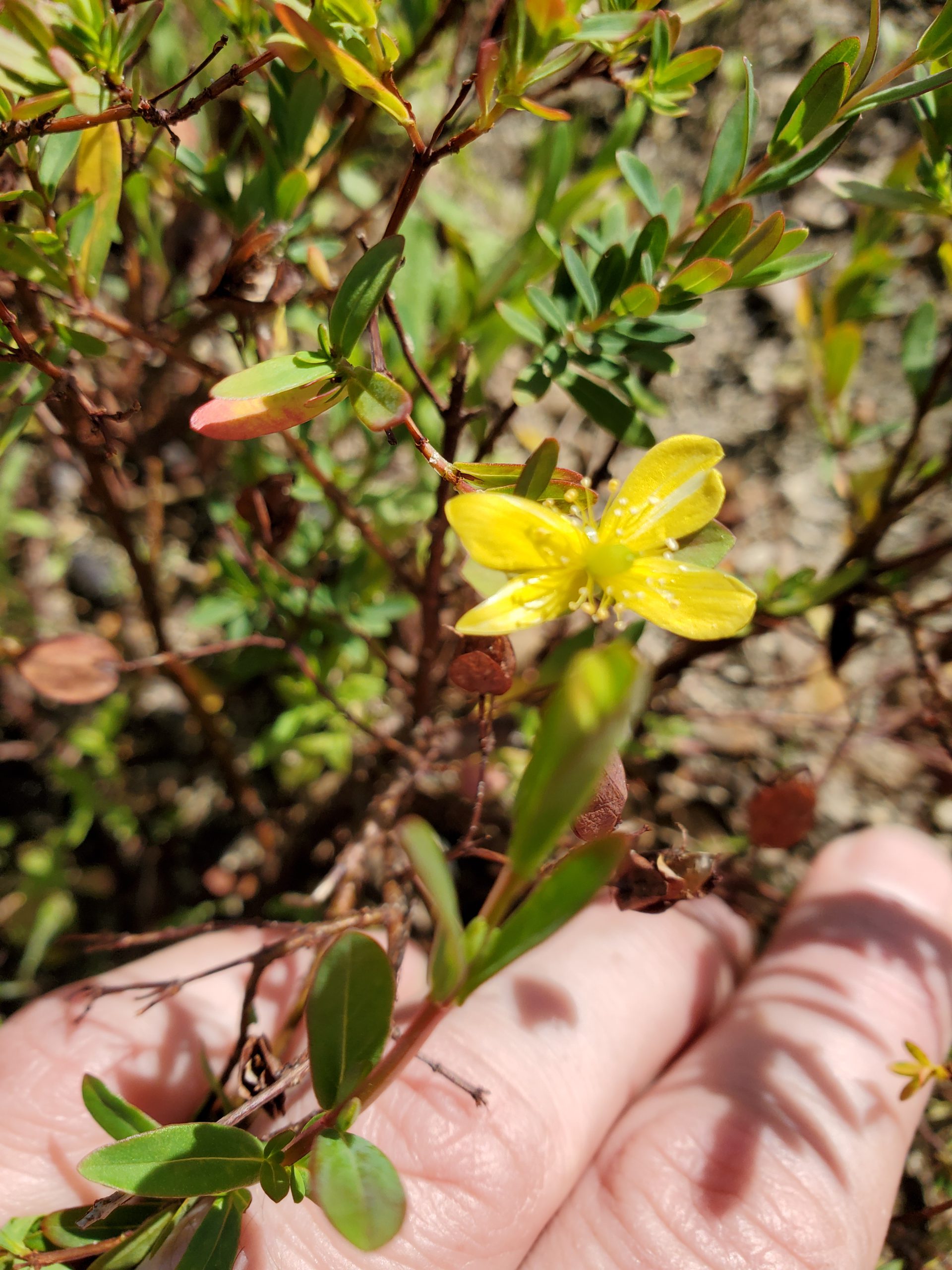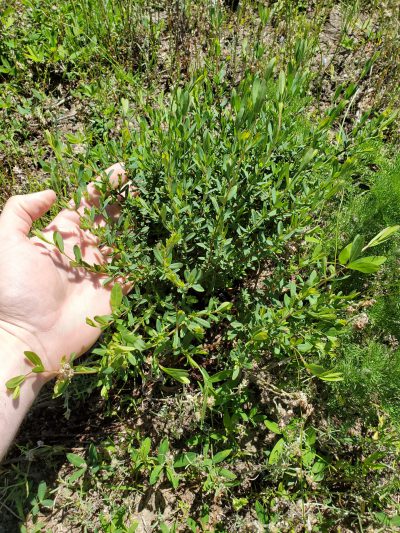
St. Andrew’s Cross (Hypericum hypericoides) in a Calhoun County perennial peanut field. Photo credit: Daniel Leonard, UF/IFAS
On my last site consultation before COVID-19 confined everyone to our offices and homes, I visited with a local perennial peanut hay farmer who was very concerned about a “new” weed infiltrating a pasture which is two years into the establishment phase. He was particularly worried because it had managed to escape his February glyphosate + 2,4-D amine burn-down application totally unscathed. Upon arrival, it was plain the 15 acre pasture was indeed infested with several hundred plants per acre of the native and sometimes nuisance pasture weed, St. Andrew’s Cross (Hypericum hypericoides).
St. Andrew’s Cross is a smallish (18”- 3’ in height) shrubby perennial native to the eastern and central US, Mexico, Central America and much of the Caribbean. It is characterized by its extremely tough nature, reddish-brown peely bark, woody twigs, opposite leaves and cross-shaped showy yellow flowers. Unfortunately for this farmer in Calhoun County, St. Andrew’s Cross is ubiquitous to the wet flatwoods areas that dominate much of our pastureland. However, it can also be found along floodplain forests, wet hammocks, near the edges of the numerous cypress domes and gum ponds and even persists in sandhills. If you haven’t run across it yet, there’s a good chance that you could!

St. Andrew’s Cross just before herbicide application was made. Photo credit: Daniel Leonard, UF/IFAS
St. Andrew’s Cross is not normally a significant weed in Bahia and Bermudagrass pastures, where growers have access to numerous herbicide options containing active ingredients extremely effective on woody broadleafs (i.e. Triclopyr), but it can occasionally become a pest in perennial peanut pastures due to the limited weed control options. Since there are only four active ingredients effective on broadleaf weeds labeled for legal use in perennial peanut, and the farmer had already demonstrated that label rates of Glyphosate and 2-4D amine were ineffective, his only legal herbicide option to control St. Andrew’s Cross was hexazinone (Velpar).
While hexazinone is the primary option for St. Andrew’s Cross control in perennial peanut (should the plant become a big enough problem to warrant spraying), growers will have to weigh the herbicide’s drawbacks against the benefits of control.
On established stands, apply 1 pt/A for control of winter weeds when perennial peanut is dormant. If weeds are emerged at time of application, use surfactant at 1 pt/100 gal. If perennial peanut is not dormant during the time of the application, expect injury and yield loss. During the season, Velpar can be applied after hay removal, but before perennial peanut regrowth has occurred. In this situation, no surfactant is needed, but weed control is often marginal. If peanuts have leafed out, expect moderate to severe injury. Source: Weed Control in Perennial Peanut
As painful as it may be for those of us who prefer to control our weeds from a tractor, the best option for St. Andrew’s Cross control, if severe peanut stand injury can’t be tolerated or if surrounding hardwoods are to be preserved, might be hand pulling.
UF/IFAS Extension Agents across the Panhandle are here to help growers any way we can, even through this COVID-19 crisis. As always, if you have any questions or concerns about weeds in perennial peanut fields or any other agronomic topic, reach out to your local county agent! We’re here to help.
- Stay Ahead of Peanut Fungal Pathogens This Summer - August 8, 2025
- Panhandle Cotton Acres Are Down in 2025– Here’s the Reason - July 11, 2025
- It Snowed, But Has This Been a Historically Cold Winter? What the Data Says. - January 31, 2025
